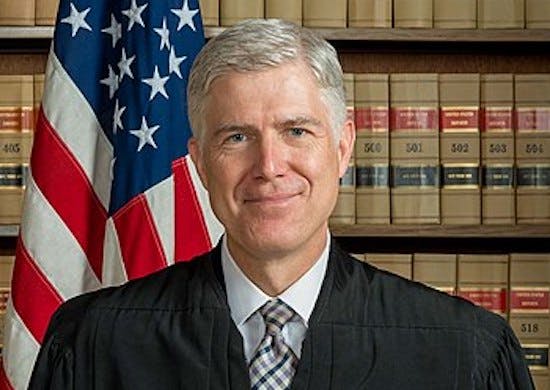Gorsuch Laces Into Second Circuit for Allowing a Court To Appoint a Prosecutor When Justice Department Takes a Powder
His dissent echoes Justice Scalia and signals future debates over what is and isn’t allowed under separated powers.

The dissent penned by Justice Neil Gorsuch and joined by Justice Brett Kavanaugh protesting the denial of certiorari in a case involving a court0appointed prosecutor cuts to constitutional bedrock and tees up further clashes over the separation of powers.
In choosing to write a dissent despite falling two justices short of the quorum required to hear the case, Donziger v. United States, the two justices signaled that the questions raised deserved a hearing at a moment of white-hot focus on prosecutorial discretion.
Donziger’s story begins in the rainforests and streams of Ecuador, whose inhabitants sued Texaco, Chevron’s predecessor, for injuries they allege percolated from its pollution. Texaco angled for the case to be heard in Ecuador, which proved a blunder, as that country’s courts rendered an $8.6 billion judgment against it.
Now called Chevron, the oil giant punched back in the Southern District of New York, and scored a nationwide injunction against the judgment and a constructive trust on all the assets already received by the Ecuadorians’ representative, Steven Donziger.
The district court ordered Donziger to surrender all of his devices as part of the discovery it granted Chevron into his holdings, and he refused to comply. The court referred him to the United States attorney’s office for prosecution for contempt. The government “respectfully declined” to press charges.
The district court then, in Justice Gorsuch’s telling, “responded by setting up and staffing its own prosecution,” which secured a conviction and a sentence of six months behind bars. Donziger objected, arguing that the court “had no lawful authority to override the Executive Branch’s nonprosecution decision.”
Donziger also argued that the system of separated of powers “exists in no small measure to keep courts from becoming partisans in cases before them.” A panel of riders of the Court of Appeals for the Second Circuit, though, affirmed his conviction on appeal, with only Judge Steven Menashi (a former member of the editorial staff of the Sun) dissenting. Now, two justices have lined up behind him.
Justice Gorsuch acknowledges that an exotic high court precedent stands in the way of Donziger’s claim. In 1987, a fractured Supreme Court ruled in Young v. United States ex rel. Vuitton et Fils S.A. that courts could appoint private attorneys as prosecutors as a “last resort” in some cases of criminal contempt.
The opinion, by Justice William Brennan, reasons that a court’s “ability to institute a contempt proceeding is therefore essential to the vindication of its authority in a way that the ability to determine guilt or innocence is not.” The judiciary must retain for itself the “ability to punish disobedience to judicial orders” independent of the executive branch.
Justice Scalia, in sharp disagreement, wrote that “prosecution of individuals who disregard court orders” is “not an exercise of ‘[t]he judicial power of the United States.’” He adds that the “judicial power does not generally include the power to prosecute crimes,” but rather encompasses the “power to decide, in accordance with law, who should prevail in a case or controversy.” Courts, he maintained, are meant to be “neutral adjudicators.”
That line of argument is picked up by Judge Menashi, who asserts that Donziger’s experience “is not how defendants are prosecuted in a system of separated powers.” He quotes United States v. Nixon to the effect that “the executive branch has exclusive authority and absolute discretion to decide whether to prosecute a case.”
Judge Menashi dissents from a “split-the-baby approach to federal power — under which the executive must have the power to oversee a prosecution but the judiciary may decide to initiate one.” Justice Gorsuch concurs from above, asking “exactly what law gives federal district courts the extraordinary power to appoint inferior executive officers to serve as prosecutor in proceedings before them?”
Judge Menashi’s fellow riders — Michael Park and William Nardini — voted to affirm on the twin pillars of Young and another case, Morrison v. Olson, the high court’s last word on special prosecutors. Judges Park and Nardini found that the prosecutors were “inferior officers” under the Constitution’s Appointments Clause and thus could be appointed by “Courts of Law.” All three circuit riders were appointed by President Trump.
The Appointments Clause ordains that the president “shall nominate, and by and with the Advice and Consent of the Senate, shall appoint Ambassadors, other public Ministers and Consuls, Judges of the supreme Court, and all other Officers of the United States, whose Appointments are not herein otherwise provided for, and which shall be established by Law: but, the Congress may by Law vest the Appointment of such inferior Officers, as they think proper, in the President alone, in the Courts of Law, or in the Heads of Departments.”
Justice Gorsuch parries the Second Circuit’s reliance on the Appointments Clause by that favored Supreme Court pastime — asking hypothetical questions — querying, “Who really thinks that the President may choose law clerks for my colleagues, that we can pick White House staff for him, or that either he or we are entitled to select aides for the Speaker of the House?”
Justice Gorsuch asserts that the “prosecution in this case broke a basic constitutional promise essential to our liberty,” and appears to write with one eye toward a future Supreme Court rather than the one in the present that “failed to intervene today.”
The justice urges his successors on the bench and high courts yet to come to overrule Young and “consider carefully Judge Menashi’s dissenting opinion” because “our Constitution does not tolerate what happened here.”

